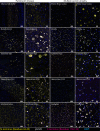N-terminus α-synuclein detection reveals new and more diverse aggregate morphologies in multiple system atrophy and Parkinson's disease
- PMID: 39726015
- PMCID: PMC11673343
- DOI: 10.1186/s40035-024-00456-3
N-terminus α-synuclein detection reveals new and more diverse aggregate morphologies in multiple system atrophy and Parkinson's disease
Abstract
Background: Parkinson's disease (PD) and multiple system atrophy (MSA) are classified as α-synucleinopathies and are primarily differentiated by their clinical phenotypes. Delineating these diseases based on their specific α-synuclein (α-Syn) proteoform pathologies is crucial for accurate antemortem biomarker diagnosis. Newly identified α-Syn pathologies in PD raise questions about whether MSA exhibits a similar diversity. This prompted the need for a comparative study focusing on α-Syn epitope-specific immunoreactivities in both diseases, which could clarify the extent of pathological overlap and diversity, and guide more accurate biomarker development.
Methods: We utilised a multiplex immunohistochemical approach to detect multiple structural domains of α-Syn proteoforms across multiple regions prone to pathological accumulation in MSA (n = 10) and PD (n = 10). Comparison of epitope-specific α-Syn proteoforms was performed in the MSA medulla, inferior olivary nucleus, substantia nigra, hippocampus, and cerebellum, and in the PD olfactory bulb, medulla, substantia nigra, hippocampus, and entorhinal cortex.
Results: N-terminus and C-terminus antibodies detected significantly more α-Syn pathology in MSA than antibodies for phosphorylated (pS129) α-Syn, which are classically used to detect α-Syn. Importantly, C-terminus immunolabelling is more pronounced in MSA compared to PD. Meanwhile, N-terminus immunolabelling consistently detected the highest percentage of α-Syn across pathologically burdened regions of both diseases, which could be of biological significance. As expected, oligodendroglial involvement distinguished MSA from PD, but in contrast to PD, no substantial astrocytic or microglial α-Syn accumulation in MSA occurred. These data confirm glial-specific changes between these diseases when immunolabelling the N-terminus epitope. In comparison, N-terminus neuronal α-Syn was present in PD and MSA, with most MSA neurons lacking pS129 α-Syn proteoforms. This explains why characterisation of neuronal MSA pathologies is lacking and challenges the reliance on pS129 antibodies for the accurate quantification of α-Syn pathological load across α-synucleinopathies.
Conclusions: These findings underscore the necessity of utilising a multiplex approach to detect α-Syn, most importantly including the N-terminus, to capture the entire spectrum of α-Syn proteoforms in α-synucleinopathies. The data provide novel insights toward the biological differentiation of these α-synucleinopathies and pave the way for more refined antemortem diagnostic methods to facilitate early identification and intervention of these neurodegenerative diseases.
Keywords: Epitope-specific; Lewy body diseases; Multiple system atrophy; Multiplex; N-terminus; Parkinson’s disease; Truncational variants; α-Synuclein.
© 2024. The Author(s).
Conflict of interest statement
Declarations. Ethics approvals and consent to participate: Human post-mortem brain tissues used in this study were received from (1) the Sydney Brain Bank, and (2) the Neurological Foundation Human Brain Bank (New Zealand). All brain tissues were donated with written informed consent from donors and their families prior to brain removal and all protocols were approved by the University of Sydney Human Research Ethics Committee (2019/491) and the University of Auckland Human Participants Ethics Committee (011654). All experiments were conducted in accordance with relevant guidelines and regulations. Consent for publication: Not applicable. Competing Interests: The authors declare no competing financial or non-financial interests.
Figures






References
-
- Peelaerts W, Baekelandt V. ɑ-Synuclein strains and the variable pathologies of synucleinopathies. J Neurochem. 2016;139:256–74. - PubMed
Publication types
MeSH terms
Substances
LinkOut - more resources
Full Text Sources
Medical
Research Materials
Miscellaneous

